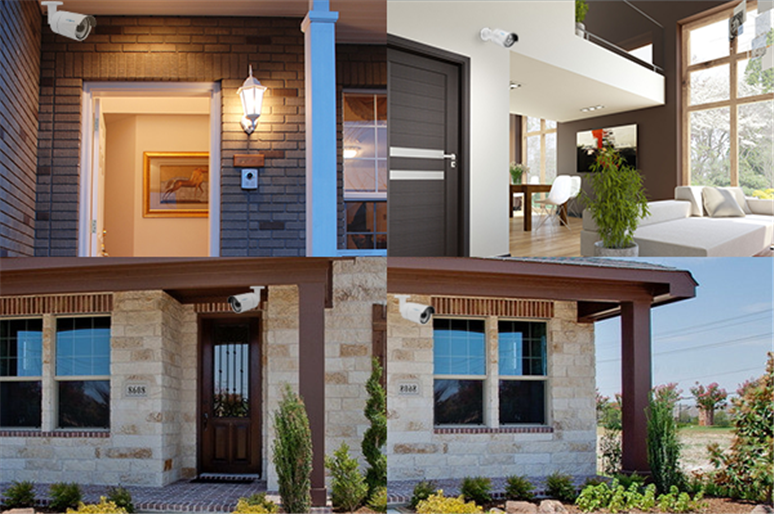Ensuring optimal security camera placement is a strategic step towards creating a robust surveillance system for your home or business. The effectiveness of your security cameras relies heavily on their positioning, capturing critical footage and deterring home break-ins and keep your family, and property safe from vandals and burglars. However, whatever security camera you choose, its effectiveness can be influenced by where you place it. So knowing where to place security cameras around your home is extremely important.
1. Where to Place Security Cameras: Best Locations and Positions
The following are some recommended spots for security camera placement according to home security statistics.
- Front Door
- Back Door
- Off-Street Windows
- Other Important Places
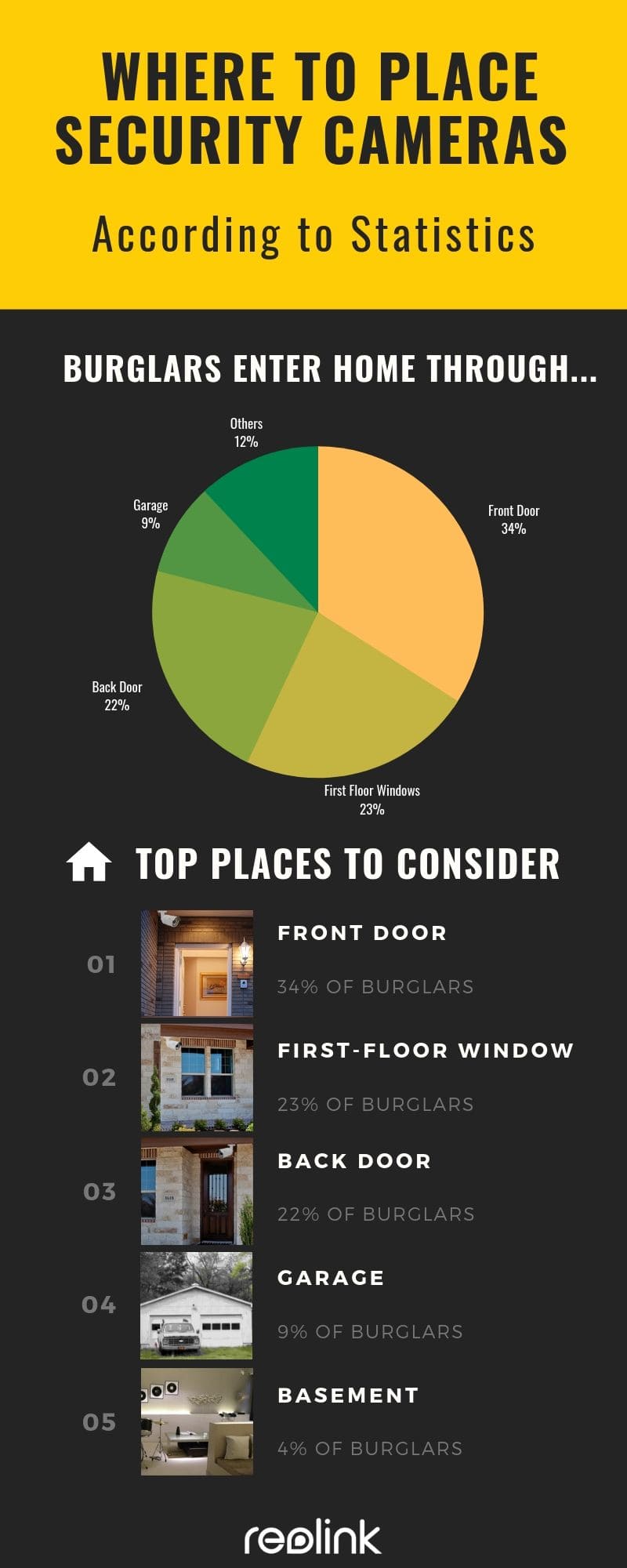
Install Surveillance Cameras at the Front Door
Around 34% of burglars enter through the front door, so you definitely need a security camera watching. Actually, this is the most important security camera placement outside home. Place your camera at second-floor level to avoid a burglar from knocking out your camera. If you only have one level, you could enclose your front door security camera in a mesh wiring to help protect it from tampering.
If you don't want to use a camera, you can replace your existing doorbell with a doorbell camera. Some doorbell cameras can work without WiFi and don't require any subscription.
Extra tip: How to Choose a Front Door Security Camera
Locate Home Security Cameras at the Back Door
Up to 22% of thieves invade your house through the back door, so you would benefit from using a camera here. This includes side doors as well. Actually, you should attach security camera to every door you have in case of intrusion. Again, try to keep it out of the reach of humans or things they can throw at a camera.
Put CCTV Cameras Near Off-Street Windows
About 23% of the burglars will also break into a home by entering through a rear window, away from the view of the street. They decrease their chances of getting caught by being away from any cars passing by. So you can point a camera to off-street windows to keep those windows safe from thieves and vandals.
Quick decisions: Place the camera above the front door and off-street windows (at about 9 feet above the ground) to cover the most vulnerable areas around your home and avoid potential vandalism. Also consider putting the camera at the back door, the garage, the basement, the driveway or the second floor for higher level security. But take a second thought if you want to place the camera inside your home behind a glass window, which may cause window glare and other problems.
Other Places You May Consider to Put CCTV Cameras
After securing the front door, back door and off-street windows with security cameras, you have prevented about 80% of the burglars from breaking into your home.
To make your home even safer, there are also some other places you may consider in the security camera layout:
- Garage
- Basement
- Second floor
- Driveways
Also check our videos to find out what are the suitable places to put your home security cameras:
2. Where to Place Cameras for Home Security: What to Consider
Visible or hidden cameras:
The debate on whether to keep cameras visible or hidden continues. Some argue that visible cameras act as deterrents, while others believe hidden cameras offer a tactical advantage. Consider your security goals and the potential impact on intruders.
Durability for Outdoor Cameras:
Outdoor cameras are exposed to various weather conditions. Choose cameras with robust designs, weather-resistant features, and suitable temperature ranges to withstand the elements.
Reflection and glare:
Be mindful of reflective surfaces, particularly in sunny or mirrored spaces. Opt for cameras with High Dynamic Range (HDR) rather than Standard Dynamic Range (SDR) for outdoor settings to minimize the effects of glare. Indoors, position cameras away from direct sunlight.
The number of security cameras:
How many security cameras do I need to cover all these areas? Actually, no one can tell it accurately because it also depends on the security camera types and how you locate the exterior cameras.
You may assess how the number of cameras may impact your Internet speed, especially if they rely on Wi-Fi. Consider setting up a dedicated router for your security cameras to ensure consistent performance.
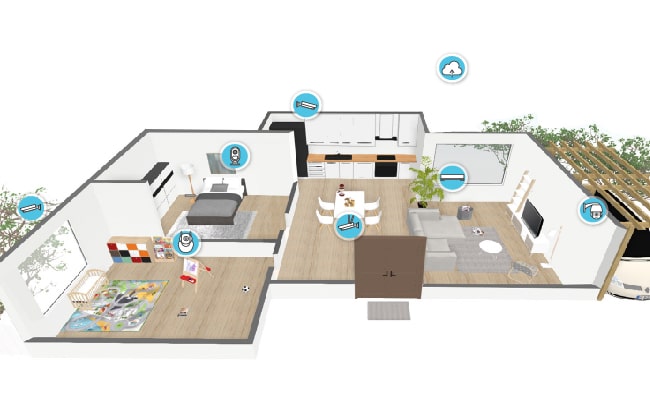
Out of reach of criminals:
To prevent tampering or theft, position cameras in locations that are not easily accessible to intruders. Ensure they are mounted securely to walls or ceilings and consider protective casings where necessary.
Power sources:
Ensure cameras have access to power sources, whether through wired connections or reliable battery solutions. Consider power over Ethernet (PoE) for wired cameras.
Proximity to valuables:
Identify and prioritize areas housing your most valuable objects when deciding camera placement. Statistics from the Bureau of Justice indicate that burglars often target household appliances, electronics, jewelry, and more. Secure these high-value areas with strategic camera placement.
3. Common Mistakes on Security Cameras Placement at Home
Both indoor and outdoor security camera placement decides if your camera will work at its best. Take a look at these common mistakes so you can avoid them when considering where to place home security cameras.
Forget to Secure Indoor and Outdoor Surveillance Cameras
One of the biggest mistakes people make is not securing their security devices, which means surveillance cameras can be easily tampered with. So where to place outdoor home security cameras to avoid possible vandalism? Generally, put the camera 9 feet above the ground will be safe.
Security camera placement inside and outside home may be a little different, since outdoor security cameras are easier to be damaged in harsh weather conditions, or stolen by thieves.
Think Cameras are Able to Multitask
Cameras are not able to multitask. You need to decide what task you want your camera to perform when considering the placement. People often forget the camera cannot pick up someone’s face, license plate, and the house across the street all at once, if they don’t have a plan of where to place home security cameras ahead. Preparing a home security camera placement diagram is important so that every camera plays its biggest role.
Place Cameras at the Highest Point
Many people place their cameras at the highest point of their property, thinking it is the best site to put CCTV camera to view full place. While it will give you a larger view, you will not get a very detailed look at any criminal’s features. You may catch just a figure on the camera instead of being able to identify a person, unless you install a PTZ security camera, which sees details as well as large view angles without damaging the video quality.
Use Cameras without a Wide Dynamic Range at Doorways and Windows
Many of you may fail to take whether the camera is WDR enabled into account on how to locate exterior cameras (especially those at doorways and windows), resulting in the hardly identifiable images.
What’s WDR in CCTV/IP cameras? When part of an image is extremely dark but another part is bright, you can’t see any details in the dark area without WDR (wide dynamic range) in the camera, as the below image shows.

So when you making decisions on where to place home security cameras, make sure the cameras for entrances have the WDR feature.
Fail to Provide Enough Lighting
No matter where you place home security cameras, don’t forget to deal with the lighting issue for night time monitoring. If yours are not night vision security cameras, you should provide enough lighting so as to record clear footage even in the dark. However, putting cameras too close to bright lights will cause the picture to be disrupted. And outdoor video surveillance camera pointing to direct sunlight will cause stripes in the image.
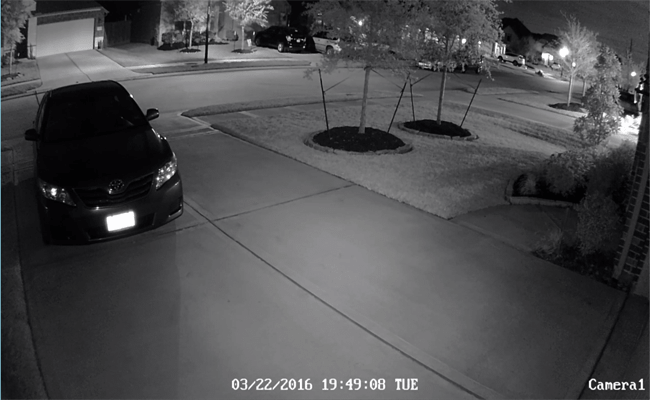
4. Where Not To Place Security Camera
While security cameras are invaluable for safeguarding your home, it's crucial to exercise caution and respect legal and privacy boundaries. Here are areas where you definitely shouldn't place security cameras:
Neighbor's property:
Avoid placing cameras that capture footage on your neighbor's property. Check your state's laws regarding surveillance to ensure compliance. Focusing cameras solely on your own premises prevents legal complications and respects your neighbor's privacy.
Bedrooms:
Bedrooms are private spaces where individuals expect a high level of privacy. Even if you store valuables in your bedroom, it's recommended to refrain from installing security cameras in this area to maintain the sanctity of personal spaces.
Bathrooms:
Similar to bedrooms, bathrooms are intimate spaces where privacy is paramount. Given that burglars are unlikely to target bathrooms, there's little security risk in leaving them unmonitored. Avoid placing cameras in bathrooms to uphold privacy standards.
5. Best Home Surveillance Cameras
Have a clear idea of where to position CCTV cameras at home already? Here is an easy-to-install option suitable for all CCTV camera placement, indoors and outdoors.
Best battery powered security camera for home - Reolink Argus 3 Pro
Rechargeable battery powered, Reolink Argus 3 Pro is highly portable and easy to install with NO wires at all! You can place it anywhere, like the front door, back door, off-street windows, simply anywhere.
The battery powered camera, thanks to its flexibility, easy installation and affordable price, has already become the first choice for people to boost their home security. It will start recording if there is any movement, so you will know all that matters during the past days, weeks even months. Matching it with a solar panel, you don’t need to even think about the battery recharging.
Learn how install the home security camera Reolink Argus 3 Pro:
Best PoE security camera for home - RLC-81PA
RLC-81PA Smart 4K 8MP 180° Pan Rotation PoE Security Camera, a groundbreaking solution for advanced surveillance. With its expansive 180° pan rotation, this camera ensures comprehensive coverage, minimizing blind spots for heightened security. Boasting 4K 8MP Ultra HD capabilities, it delivers crystal-clear imagery, capturing every detail with precision. The innovative Color Night Vision technology sets it apart, providing vivid, full-color visuals in low-light conditions.
Designed for user convenience, the RLC-81PA offers easy installation with Power over Ethernet (PoE) technology, eliminating the need for additional power cables.
Bonus Tips: The motion detection will be more accurate if you put the camera in the direction crossing the possible intruder instead of facing it. For example, the best home security camera placement should be like this:
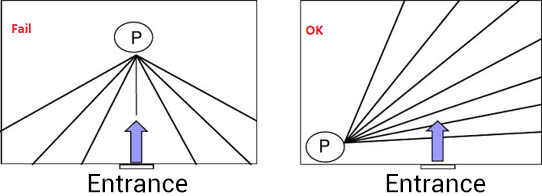
Want to take a look at other camera types before final decision? Check the list that covers all types of security camera (bullet camera, dome camera, PTZ camera, cameras without network, and more) and best quality picks for home security.
6. Check Home Security Camera Placement Laws
When strategically placing home security cameras, it's essential to avoid common mistakes and choose optimal spots for installation. However, beyond considering camera placement for effectiveness, it's crucial to be mindful of security camera placement laws. To prevent legal complications and respect privacy, it is imperative to understand the regulations surrounding surveillance.
In the United States, federal law, particularly the Fourth Amendment, protects homes from unwarranted surveillance. It is illegal to point security cameras at others' properties, including roofs, windows, or lights, as this invasion of privacy is considered a violation of the law. This legal restriction holds even if the surveillance is unintentional or conducted from a public or privately-owned location.
Moreover, security camera placement laws vary from state to state. Therefore, it is strongly advised to thoroughly research and understand your state's statutes before installing security cameras.
Conclusion
Strategic security camera placement is a pivotal aspect of creating a robust and effective surveillance system for your home or business. By following the top 6 tips on security camera placement outlined in this guide, you can maximize coverage, deter potential threats, and enhance the overall security of your property.
If you like this article and find it helpful, share it with your friends. Do you have something to say about security cameras placement? Make sure you leave a comment below!

